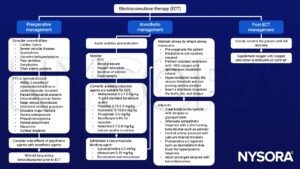Learning objectives
- Understand the effects of Electroconvulsive therapy (ECT)
- Anesthetic management of ECT
Definitions and mechanisms
- Electroconvulsive therapy (ECT) is a procedure in which small electric currents are passed through the brain to intentionally trigger a brief tonic-clonic epileptic seizure
- Is a safe and effective treatment for severe medication-resistant depression
- Can also be beneficial in:
- Severe mania
- Catatonia
- Agitation and aggression in people with dementia
- Schizophrenia
- Performed under general anesthesia
- Modern ECT devices deliver brief electrical stimuli via two electrodes and are equipped with controls to adjust the duration and frequency of the stimulus
- The electrodes can either be attached on both sides of the head, typically bitemporal, for bilateral ECT or on the dominant hemisphere for unilateral ECT
Effects
| Cardiovascular effects | Bradycardia Hypotension Possibly asystole Systolic arterial pressure may increase by 30-40% Heart rate may increase by 20% or peak at 3-5 min Myocardial oxygen consumption increases while myocardial oxygen supply may be reduced due to Left ventricular systolic and diastolic function can remain decreased up to 6 h after ECT |
| Cerebral effects | Increase in: Cerebral oxygen consumption Blood flow Intracranial pressure Reports of: Transient ischemic deficits Intracranial hemorrhage Cortical blindness Prolonged Seizures Status epilepticus Postictal: Disorientation Impaired attention Memory problems Short-term memory impairment lasting several weeks Permanent memory loss Retrograde and aterograde amnesia |
| Other physiological effects | Increased intraocular pressure Increased intragastric pressure |
| General physical effects | Headaches Myalgia Drowsiness Weakness Nausea Anorexia Increased salivation Dental damage Oral cavity lacerations |
Management

Suggested reading
- Pollard BJ, Kitchen, G. Handbook of Clinical Anaesthesia. Fourth Edition. CRC Press. 2018. 978-1-4987-6289-2.
- Uppa Vl, Dourish J, Macfarlane A. Anaesthesia for electroconvulsive therapy. Continuing Education in Anaesthesia Critical Care & Pain. 2010. 10;(6); 192-196.
We would love to hear from you. If you should detect any errors, email us customerservice@nysora.com

